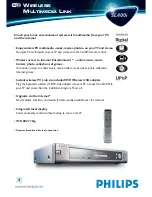
6
General Maintenance Schedule
Weekly:
General cleaning (see cleaning procedures).
Annually:
Re-calibrate air flow sensor
Cleaning and Sanitizing
Most components consist of cast acrylic, thermoplastics and 304 stainless steel. Like any piece
of fine laboratory equipment, care should be taken to avoid dropping, mishandling, and
misapplication.
Cleaning
Cleaning thermoplastics is best accomplished with a non-abrasive soap or detergent and water
solution. In cases where residues left by the agents is undesirable, special cleaning solvents
may be used. Soaps and detergents will not harm plastics, but several common solvents will.
Recommended cleaners include Novus™ Plastic Polish #1, Brillianize™ cleaner, and Rez-N-
Kleen™
In general, aromatic and chlorinated hydrocarbons will attack most plastic surfaces. This
applies to all plastics used in these products.
Examples
of these products include, but are not limited to, acetone, ether, gasoline, lacquer
thinner, methyl-ethyl-ketone, methylene chloride, and toluene.
Polishes
While the above cleaning solutions have some polishing capabilities, they will not remove
scratches from plastic. This can only be done with automotive type
waxes
or the finer grades of
rubbing or polishing compounds. These products should be specifically for acrylic enamels and
lacquer base paint.
Scratch Removers
Deep scratches should be first sanded with a fine grit (600 or finer) wet sandpaper. Steel wool
(0000 finest grade) is also very helpful. Use the polishing materials (rubbing compounds)
mentioned above for the final stage.
Sterilizing
There are several commercially available sterilizing agents and technologies that can be used
on the cast acrylic isolator. These include:
•
Formaldehyde
•
Vaporized Hydrogen
Peroxide
(VHP)
•
Chlorine
Dioxide
gas
•
Clidox™
•
Diluted Isopropyl alcohol (70%/30%)
Summary of Contents for VBE204
Page 4: ...3 General Information ...





























